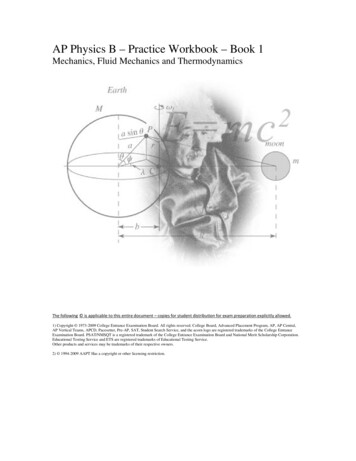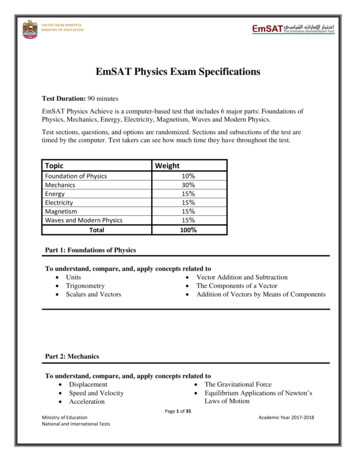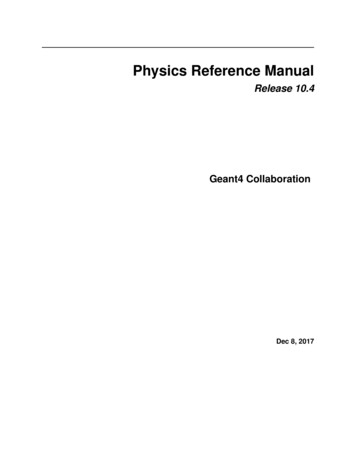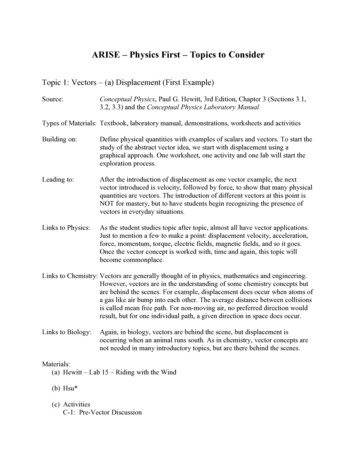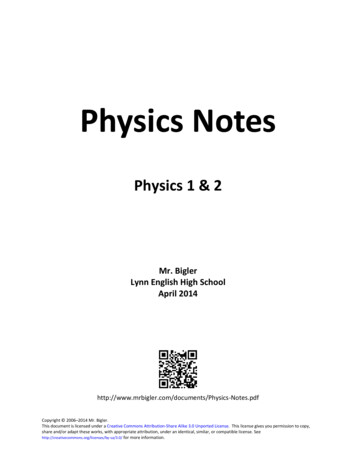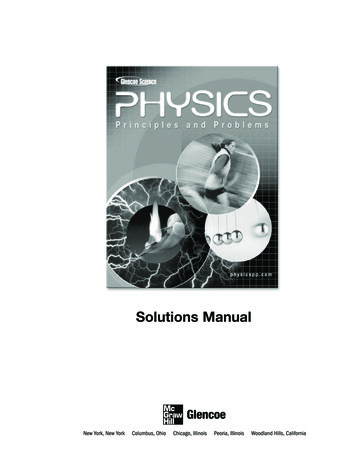
Transcription
Solutions Manual
A Glencoe ProgramStudent EditionTeacher Wraparound EditionTeacher Chapter ResourcesMini Lab WorksheetsPhysics Lab WorksheetsStudy GuideSection QuizzesReinforcementEnrichmentTransparency MastersTransparency WorksheetsChapter AssessmentTeacher Classroom ResourcesTeaching TransparenciesLaboratory Manual, Student EditionLaboratory Manual, Teacher EditionProbeware Laboratory Manual, StudentEditionProbeware Laboratory Manual, TeacherEditionForensics Laboratory Manual, StudentEditionForensics Laboratory Manual, TeacherEditionSupplemental ProblemsAdditional Challenge ProblemsPre-AP/Critical Thinking ProblemsPhysics Test Prep: Studying for theEnd-of-Course Exam, Student EditionPhysics Test Prep: Studying for theEnd-of-Course Exam, Teacher EditionConnecting Math to PhysicsSolutions ManualTechnologyAnswer Key MakerExamView ProInteractive ChalkboardMcGraw-Hill Learning NetworkStudentWorks CD-ROMTeacherWorks CD-ROMphysicspp.com Web siteCopyright by The McGraw-Hill Companies, Inc. All rights reserved. Permission is grantedto reproduce the material contained herein on the condition that such material be reproduced only for classroom use; be provided to students, teachers, and families withoutcharge; and be used solely in conjunction with the Physics: Principles and Problemsprogram. Any other reproduction, for use or sale, is prohibited without prior written permissionof the publisher.Send all inquiries to:Glencoe/McGraw-Hill8787 Orion PlaceColumbus, Ohio 43240ISBN 0-07-865893-4Printed in the United States of America1 2 3 4 5 6 7 8 9 045 09 08 07 06 05 04
ContentsCopyright Glencoe/McGraw-Hill, a division of The McGraw-Hill Companies, Inc.To the Teacher . . . . . . . . . . . . . . . . . . . . . . ivChapter 1A Physics Toolkit . . . . . . . . . . . . . . . . . . . . 1Chapter 17Reflection and Mirrors . . . . . . . . . . . . . . 357Chapter 2Representing Motion . . . . . . . . . . . . . . . . 15Chapter 18Refraction and Lenses . . . . . . . . . . . . . . 377Chapter 3Accelerated Motion . . . . . . . . . . . . . . . . . 29Chapter 19Interference and Diffraction . . . . . . . . . 399Chapter 4Forces in One Dimension . . . . . . . . . . . . 61Chapter 20Static Electricity . . . . . . . . . . . . . . . . . . . 413Chapter 5Forces in Two Dimensions . . . . . . . . . . . 87Chapter 21Electric Fields . . . . . . . . . . . . . . . . . . . . . 427Chapter 6Motion in Two Dimensions . . . . . . . . . 115Chapter 22Current Electricity . . . . . . . . . . . . . . . . . 445Chapter 7Gravitation . . . . . . . . . . . . . . . . . . . . . . . 141Chapter 23Series and Parallel Circuits . . . . . . . . . . 463Chapter 8Rotational Motion . . . . . . . . . . . . . . . . . 169Chapter 24Magnetic Fields . . . . . . . . . . . . . . . . . . . 485Chapter 9Momentum and Its Conservation . . . . 193Chapter 25Electromagnetic Induction . . . . . . . . . . 501Chapter 10Energy, Work, and Simple Machines . . 225Chapter 26Electromagnetism . . . . . . . . . . . . . . . . . . 517Chapter 11Energy and Its Conservation . . . . . . . . . 247Chapter 27Quantum Theory . . . . . . . . . . . . . . . . . . 531Chapter 12Thermal Energy . . . . . . . . . . . . . . . . . . . 271Chapter 28The Atom . . . . . . . . . . . . . . . . . . . . . . . . 545Chapter 13States of Matter . . . . . . . . . . . . . . . . . . . 287Chapter 29Solid-State Electronics . . . . . . . . . . . . . . 559Chapter 14Vibrations and Waves . . . . . . . . . . . . . . 311Chapter 30Nuclear Physics . . . . . . . . . . . . . . . . . . . 573Chapter 15Sound . . . . . . . . . . . . . . . . . . . . . . . . . . . 329Appendix BAdditional Problems . . . . . . . . . . . . . . . 591Chapter 16Fundamentals of Light . . . . . . . . . . . . . 345Physics: Principles and ProblemsContentsiii
To the TeacherThe Solutions Manual is a comprehensive guide to the questions and problems in the Student Edition ofPhysics: Principles and Problems. This includes the Practice Problems, Section Reviews, Chapter Assessments,and Challenge Problems for each chapter, as well as the Additional Problems that appear in Appendix Bof the Student Edition. The Solutions Manual restates every question and problem so that you do not haveto look back at the text when reviewing problems with students.Copyright Glencoe/McGraw-Hill, a division of The McGraw-Hill Companies, Inc.ivTo the TeacherPhysics: Principles and Problems
CHAPTER1A Physics ToolkitPractice Problems1.1Mathematics and Physicspages 3–10page 5For each problem, give the rewritten equation youwould use and the answer.1. A lightbulb with a resistance of 50.0 ohmsis used in a circuit with a 9.0-volt battery.What is the current through the bulb?V9.0 voltI 0.18 ampereR50.0 ohms2. An object with uniform acceleration a,starting from rest, will reach a speed of vin time t according to the formula v at.What is the acceleration of a bicyclist whoaccelerates from rest to 7 m/s in 4 s?vt7 m/s4sCopyright Glencoe/McGraw-Hill, a division of The McGraw-Hill Companies, Inc.a 1.75 m/s23. How long will it take a scooter acceleratingat 0.400 m/s2 to go from rest to a speed of4.00 m/s?va4.00 m/s0.400 m/st 2 10.0 s4. The pressure on a surface is equal to theforce divided by the area: P F/A.A 53-kg woman exerts a force (weight) of520 Newtons. If the pressure exerted onthe floor is 32,500 N/m2, what is the areaof the soles of her shoes?FP520 N32,500 N/m2A 2 0.016 mpage 7Use dimensional analysis to check your equationbefore multiplying.6. Convert 5021 centimeters to kilometers.5021 cm 1m1 km100 cm 1000 m5.021 10 2 km7. How many seconds are in a leap year?366 days 24 h 60 min 60 s1h1 day1 min31,622,400 s8. Convert the speed 5.30 m/s to km/h.5.30 m 60 s 60 min1 km 1 s 1 min 1 h 1000 m 19.08 km/hpage 8Solve the following problems.9. a. 6.201 cm 7.4 cm 0.68 cm 12.0 cm6.2017.40.68 12.0cmcmcmcm26.281 cm 26.3 cm after roundingb. 1.6 km 1.62 m 1200 cm1.6 km 1600m1.62 m 1.62 m1200 cm 12m1613.62 m 1600 m or 1.6 km after rounding10. a. 10.8 g 8.264 g10.8g 8.264 g2.536 g 2.5 g after rounding5. How many megahertz is 750 kilohertz?750 kHz 1 MHz1000 Hz1,000,000 Hz1 kHz0.75 MHzPhysics: Principles and ProblemsSolutions Manual1
Chapter 1 continuedb. 4.75 m 0.4168 m4.75 m 0.4168 ma. Substitute the values into the equationyou will use. Are the units correct?F Bqv4.3332 m 4.33 m after rounding11. a. 139 cm 2.3 cm320 cm2 or 3.2 102 cm2b. 3.2145 km 4.23 km13.6 km212. a. 13.78 g 11.3 mL1.22 g/mLb. 18.21 g 4.4 cm34.1 g/cm3 (4.5 kg/A s2)(1.60 10 19 A s)(2.4 105 m/s)Force will be measured in kg m/s2,which is correct.b. The values are written in scientificnotation, m 10n. Calculate the 10n partof the equation to estimate the size ofthe answer.10 19 105 10 14; the answer willbe about 20 10 14, or 2 10 13.c. Calculate your answer. Check it againstyour estimate from part b.1.7 10 13 kg m/s2Section Review1.1Mathematics and Physicspages 3–10page 1013. Math Why are concepts in physicsdescribed with formulas?The formulas are concise and can beused to predict new data.FF Bqv, so B qvkg m/s2(A s)(m/s)kgA sT 21 T 1 kg/A s215. Magnetism A proton with charge1.60 10 19 A s is moving at 2.4 105 m/sthrough a magnetic field of 4.5 T. You wantto find the force on the proton.2 Solutions ManualThe least-precise value is 4.5 T, with2 significant digits, so the answer isrounded to 2 significant digits.16. Magnetism Rewrite F Bqv to find v interms of F, q, and B.FBqv 17. Critical Thinking An accepted value forthe acceleration due to gravity is 9.801 m/s2.In an experiment with pendulums, youcalculate that the value is 9.4 m/s2. Shouldthe accepted value be tossed out to accommodate your new finding? Explain.No. The value 9.801 m/s2 has beenestablished by many other experiments,and to discard the finding you wouldhave to explain why they were wrong.There are probably some factorsaffecting your calculation, such asfriction and how precisely you canmeasure the different variables.Physics: Principles and ProblemsCopyright Glencoe/McGraw-Hill, a division of The McGraw-Hill Companies, Inc.14. Magnetism The force of a magnetic fieldon a charged, moving particle is given byF Bqv, where F is the force in kg m/s2, q isthe charge in A s, and v is the speed in m/s.B is the strength of the magnetic field,measured in teslas, T. What is 1 tesladescribed in base units?d. Justify the number of significant digitsin your answer.
Chapter 1 continuedd. How precise is the measure of theheight of one box? Of 12 boxes?Section Review1.2Measurementpages 11–14page 1418. Accuracy Some wooden rulers do not startwith 0 at the edge, but have it set in a fewmillimeters. How could this improve theaccuracy of the ruler?As the edge of the ruler gets worn awayover time, the first millimeter or two ofthe scale would also be worn away ifthe scale started at the edge.19. Tools You find a micrometer (a tool usedto measure objects to the nearest 0.01 mm)that has been badly bent. How would itcompare to a new, high-quality meterstickin terms of its precision? Its accuracy?It would be more precise but lessaccurate.20. Parallax Does parallax affect the precisionof a measurement that you make? Explain.21. Error Your friend tells you that his heightis 182 cm. In your own words, explain therange of heights implied by this statement.His height would be between 181.5 and182.5 cm. Precision of a measurementis one-half the smallest division on theinstrument. The height 182 cm wouldrange 0.5 cm.22. Precision A box has a length of 18.1 cm anda width of 19.2 cm, and it is 20.3 cm tall.a. What is its volume?23. Critical Thinking Your friend states in areport that the average time required tocircle a 1.5-mi track was 65.414 s. This wasmeasured by timing 7 laps using a clockwith a precision of 0.1 s. How muchconfidence do you have in the results ofthe report? Explain.A result can never be more precise thanthe least precise measurement. Thecalculated average lap time exceedsthe precision possible with the clock.Practice Problems1.3Graphing Datapages 15–19page 1824. The mass values of specified volumes ofpure gold nuggets are given in Table 1-4.Table 1-4Mass of Pure Gold NuggetsVolume (cm3)Mass (g)1.019.42.038.63.058.14.077.45.096.5a. Plot mass versus volume from thevalues given in the table and drawthe curve that best fits all points.7.05 103 cm3b. How precise is the measure of length?Of volume?nearest tenth of a cm; nearest10 cm3c. How tall is a stack of 12 of these boxes?243.6 cmPhysics: Principles and Problems100Mass (g)Copyright Glencoe/McGraw-Hill, a division of The McGraw-Hill Companies, Inc.No, it doesn’t change the fineness ofthe divisions on its scale.nearest tenth of a cm; nearest tenthof a cm80604020012345Volume (cm3)Solutions Manual3
Chapter 1 continuedb. Describe the resulting curve.a straight linec. According to the graph, what type ofrelationship exists between the mass ofthe pure gold nuggets and their volume?The relationship is linear.d. What is the value of the slope of thisgraph? Include the proper units. 19.3 g/cm3e. Write the equation showing mass as afunction of volume for gold.m (19.3 g/cm3)VWrite a word interpretation for the slopeof the line.The mass for each cubic centimeterof pure gold is 19.3 g.28. Predict Use the relation in Figure 1-18 topredict the current when the resistance is16 ohms.29. Critical Thinking In your own words,explain the meaning of a shallower line, ora smaller slope than the one in Figure 1-16,in the graph of stretch versus total mass fora different spring.The spring whose line has a smallerslope is stiffer, and therefore requiresmore mass to stretch it one centimeter.Chapter AssessmentConcept MappingSection Review1.316 g7.5 A96.5 g 19.4 g yslope x5.0 cm3 1.0 cm3f.27. Predict Use the relation illustrated inFigure 1-16 to determine the mass requiredto stretch the spring 15 cm.Graphing Datapages 15–19hypothesis0Time (s)5Speed (m/s) 12 1010 15 20 25 30 35864222experimentSpeed pendentvariableTime (s)26. Interpret a Graph What would be themeaning of a nonzero y-intercept to a graphof total mass versus volume?There is a nonzero total mass when thevolume of the material is zero. Thiscould happen if the mass valueincludes the material’s container.4 Solutions ManualgraphmathematicalmodelPhysics: Principles and ProblemsCopyright Glencoe/McGraw-Hill, a division of The McGraw-Hill Companies, Inc.page 1925. Make a Graph Graph the following data.Time is the independent variable.page 2430. Complete the following concept map usingthe following terms: hypothesis, graph,mathematical model, dependent variable,measurement.
Chapter 1 continuedMastering Conceptspage 2431. Describe a scientific method. (1.1)Identify a problem; gather informationabout it by observing and experimenting;analyze the information to arrive at ananswer.32. Why is mathematics important to science?(1.1)Mathematics allows you to be quantitative, to say “how fast,” not just “fast.”33. What is the SI system? (1.1)The International System of Units, or SI,is a base 10 system of measurementthat is the standard in science. The baseunits are the meter, kilogram, second,kelvin, mole, ampere, and candela.34. How are base units and derived unitsrelated? (1.1)The derived units are combinations ofthe base units.Copyright Glencoe/McGraw-Hill, a division of The McGraw-Hill Companies, Inc.35. Suppose your lab partner recorded ameasurement as 100 g. (1.1)a. Why is it difficult to tell the number ofsignificant digits in this measurement?Zeros are necessary to indicate themagnitude of the value, but there isno way of knowing whether or not theinstrument used to measure the values actually measured the zeros. Thezeros may serve only to locate the 1.b. How can the number of significantdigits in such a number be made clear?Write the number in scientificnotation, including only thesignificant digits.36. Give the name for each of the followingmultiples of the meter. (1.1)1a. m100centimeterPhysics: Principles and Problems1b. m1000millimeterc. 1000 mkilometer37. To convert 1.8 h to minutes, by whatconversion factor should you multiply? (1.1)60 min , because the units will cancel1hcorrectly.38. Solve each problem. Give the correct numberof significant digits in the answers. (1.1)a. 4.667 104 g 3.02 105 g3.49 105 gb. (1.70 102 J) (5.922 10 4 cm3)2.87 105 J/cm339. What determines the precision of ameasurement? (1.2)the precision of a measuring device,which is limited by the finest divisionon its scale40. How does the last digit differ from theother digits in a measurement? (1.2)The final digit is estimated.41. A car’s odometer measures the distancefrom home to school as 3.9 km. Usingstring on a map, you find the distance to be4.2 km. Which answer do you think is moreaccurate? What does accurate mean? (1.2)The most accurate measure is themeasure closest to the actual distance.The odometer is probably moreaccurate as it actually covered thedistance. The map is a model madefrom measurements, so your measurements from the map are more removedfrom the real distance.42. How do you find the slope of a lineargraph? (1.3)The slope of a linear graph is the ratioof the vertical change to the horizontalchange, or rise over run.Solutions Manual5
Chapter 1 continued43. For a driver, the time between seeing astoplight and stepping on the brakes iscalled reaction time. The distance traveledduring this time is the reaction distance.Reaction distance for a given driver andvehicle depends linearly on speed. (1.3)46. Given the equation F mv2/R, whatrelationship exists between each of thefollowing? (1.3)a. F and Rinverse relationshipb. F and ma. Would the graph of reaction distanceversus speed have a positive or anegative slope?linear relationshipc. F and vPositive. As speed increases,reaction distance increases.Larger. The driver who was distractedwould have a longer reaction timeand thus a greater reaction distanceat a given speed.Temperature is the independent variable; volume is the dependent variable.45. What type of relationship is shown inFigure 1-20? Give the general equation forthis type of relation. (1.3)ypages 25–2647. Figure 1-21 gives the height above theground of a ball that is thrown upwardfrom the roof of a building, for the first1.5 s of its trajectory. What is the ball’sheight at t 0? Predict the ball’s height att 2 s and at t 5 s.Height of Ball v. Time25201510501234Time (s) Figure 1-21When t 0 and t 2, the ball’s heightwill be about 20 m. When t 5, the ballwill have landed on the ground so theheight will be 0 m.48. Is a scientific method one set of clearlydefined steps? Support your answer.x Figure 1-20quadratic; y ax2 bx c6 Solutions ManualThere is no definite order of specificsteps. However, whatever approachis used, it always includes closeobservation, controlled experimentation,summarizing, checking, and rechecking.Physics: Principles and ProblemsCopyright Glencoe/McGraw-Hill, a division of The McGraw-Hill Companies, Inc.44. During a laboratory experiment, thetemperature of the gas in a balloon is variedand the volume of the balloon is measured.Which quantity is the independentvariable? Which quantity is the dependentvariable? (1.3)Applying ConceptsHeight (m)b. A driver who is distracted has a longerreaction time than a driver who is not.Would the graph of reaction distanceversus speed for a distracted driver havea larger or smaller slope than for anormal driver? Explain.quadratic relationship
Chapter 1 continued49. Explain the difference between a scientifictheory and a scientific law.A scientific law is a rule of nature, wherea scientific theory is an explanation ofthe scientific law based on observation.A theory explains why something happens; a law describes what happens.50. Density The density of a substance is itsmass per unit volume.a. Give a possible metric unit for density.possible answers include g/cm3 orkg/m3b. Is the unit for density a base unit or aderived unit?derived unit51. What metric unit would you use to measureeach of the following?a. the width of your handcmb. the thickness of a book covermmc. the height of your classroomCopyright Glencoe/McGraw-Hill, a division of The McGraw-Hill Companies, Inc.md. the distance from your home to yourclassroomkm52. Size Make a chart of sizes of objects.Lengths should range from less than 1 mmto several kilometers. Samples mightinclude the size of a cell, the distance lighttravels in 1 s, and the height of a room.sample answer:radius of the atom, 5 10 11 m; virus,10 7 m; thickness of paper, 0.1 mm;width of paperback book, 10.7 cm;height of a door, 1.8 m; width of town,7.8 km; radius of Earth, 6 106 m;distance to the Moon, 4 108 m53. Time Make a chart of time intervals.Sample intervals might include the timebetween heartbeats, the time betweenpresidential elections, the average lifetimeof a human, and the age of the UnitedPhysics: Principles and ProblemsStates. Find as many very short and verylong examples as you can.sample answer:half-life of polonium-194, 0.7 s;time between heartbeats, 0.8 s; time towalk between physics class and mathclass, 2.4 min; length of school year,180 days; time between elections forthe U.S. House of Representatives,2 years; time between U.S. presidentialelections, 4 years; age of the UnitedStates, (about) 230 years54. Speed of Light Two students measurethe speed of light. One obtains(3.001 0.001) 108 m/s; the other obtains(2.999 0.006) 108 m/s.a. Which is more precise?(3.001 0.001) 108 m/sb. Which is more accurate?(2.999 0.006) 108 m/s55. You measure the dimensions of a desk as132 cm, 83 cm, and 76 cm. The sum ofthese measures is 291 cm, while the productis 8.3 105 cm3. Explain how the significantdigits were determined in each case.In addition and subtraction, you askwhat place the least precise measure isknown to: in this case, to the nearestcm. So the answer is rounded to thenearest cm. In multiplication anddivision, you look at the number ofsignificant digits in the least preciseanswer: in this case, 2. So the answer isrounded to 2 significant digits.56. Money Suppose you receive 5.00 at thebeginning of a week and spend 1.00 eachday for lunch. You prepare a graph of theamount you have left at the end of each dayfor one week. Would the slope of this graphbe positive, zero, or negative? Why?negative, because the change invertical distance is negative for apositive change in horizontal distanceSolutions Manual7
Chapter 1 continued57. Data are plotted on a graph, and the valueon the y-axis is the same for each value ofthe independent variable. What is theslope? Why? How does y depend on x?Zero. The change in vertical distance iszero. y does not depend on x.58. Driving The graph of braking distanceversus car speed is part of a parabola. Thus,the equation is written d av2 bv c.The distance, d, has units in meters, andvelocity, v, has units in meters/second.How could you find the units of a, b, and c?What would they be?The units in each term of the equationmust be in meters because distance, d,is measured in meters.av 2 a(m/s)2, so a is in s2/m;bv b(m/s), so b is in s 1.59. How long is the leaf in Figure 1-22?Include the uncertainty in yourmeasurement.c. What is the number of significant digitsfor the total mass?fourd. Why is the number of significant digitsdifferent for the total mass and theindividual masses?When adding measurements, theprecision matters: both masses areknown to the nearest hundredth of agram, so the total should be given tothe nearest hundredth of a gram.Significant digits sometimes aregained when adding.61. History Aristotle said that the speed of afalling object varies inversely with the densityof the medium through which it falls.a. According to Aristotle, would a rock fallfaster in water (density 1000 kg/m3), orin air (density 1 kg/m3)?Lower density means faster speed,so the rock falls faster in air.b. How fast would a rock fall in a vacuum?Based on this, why would Aristotle saythat there could be no such thing as avacuum? Figure 1-228.3 cm 0.05 cm, or 83 mm 0.5 mm60. The masses of two metal blocks aremeasured. Block A has a mass of 8.45 gand block B has a mass of 45.87 g.a. How many significant digits areexpressed in these measurements?A: three; B: fourb. What is the total mass of block A plusblock B?62. Explain the difference between a hypothesisand a scientific theory.A scientific theory has been testedand supported many times before itbecomes accepted. A hypothesis is anidea about how things might work—ithas much less support.63. Give an example of a scientific law.Newton’s laws of motion, law of conservation of energy, law of conservation ofcharge, law of reflection54.32 g8 Solutions ManualPhysics: Principles and ProblemsCopyright Glencoe/McGraw-Hill, a division of The McGraw-Hill Companies, Inc.Because a vacuum would have azero density, the rock should fallinfinitely fast. Nothing can fall thatfast.
Chapter 1 continued64. What reason might the ancient Greekshave had not to question the hypothesisthat heavier objects fall faster than lighterobjects? Hint: Did you ever question whichfalls faster?Air resistance affects many lightobjects. Without controlled experiments, their everyday observations toldthem that heavier objects did fall faster.65. Mars Explain what observations led tochanges in scientists’ ideas about the surfaceof Mars.As telescopes improved and laterprobes were sent into space, scientistsgained more information about thesurface. When the information didnot support old hypotheses, thehypotheses changed.66. A graduated cylinder is marked every mL.How precise a measurement can you makewith this instrument? 0.5 mLCopyright Glencoe/McGraw-Hill, a division of The McGraw-Hill Companies, Inc.Mastering Problemspages 26–281.1 Mathematics and Physics67. Convert each of the followingmeasurements to meters.a. 42.3 cm0.423 mb. 6.2 pm6.2 10 12 m68. Add or subtract as indicated.a. 5.80 109 s 3.20 108 s6.12 109 sb. 4.87 10 6 m 1.93 10 6 m2.94 10 6 mc. 3.14 10 5 kg 9.36 10 5 kg1.250 10 4 kgd. 8.12 107 g 6.20 106 g7.50 107 g69. Rank the following mass measurementsfrom least to greatest: 11.6 mg, 1021 g,0.000006 kg, 0.31 mg.0.31 mg, 1021 µg, 0.000006 kg, 11.6 mg70. State the number of significant digits ineach of the following measurements.a. 0.00003 m1b. 64.01 fm4c. 80.001 m5d. 0.720 g3e. 2.40 106 kg3f.6 108 kg1g. 4.07 1016 m3c. 21 km2.1 104 md. 0.023 mm2.3 10 5 me. 214 m2.14 10 4 mf.57 nm5.7 10 8 m71. Add or subtract as indicated.a. 16.2 m 5.008 m 13.48 m34.7 mb. 5.006 m 12.0077 m 8.0084 m25.022 mc. 78.05 cm2 32.046 cm246.00 cm2d. 15.07 kg 12.0 kg3.1 kgPhysics: Principles and ProblemsSolutions Manual9
Chapter 1 continued72. Multiply or divide as indicated.a.(6.2 10182.9 109m)(4.7 10 10m)78. How precise a measurement could youmake with the scale shown in Figure 1-23?m2b. (5.6 10 7 m)/(2.8 10 12 s)2.0 105 m/sc. (8.1 10 4 km)(1.6 10 3 km)1.3 10 6 km2d. (6.5 105 kg)/(3.4 103 m3)1.9 102 kg/m373. Gravity The force due to gravity is F mgwhere g 9.80 m/s2.a. Find the force due to gravity on a41.63-kg object.408 kg m/s2b. The force due to gravity on an object is632 kg m/s2. What is its mass? Figure 1-23 0.5 g79. Give the measure shown on the meter inFigure 1-24 as precisely as you can. Includethe uncertainty in your answer.64.5 kg32405A74. Dimensional Analysis Pressure is measured in pascals, where 1 Pa 1 kg/m s2.Will the following expression give apressure in the correct units?1ACLASS A(0.55 kg)(2.1 m/s) 9.8 m/s21.2 Measurement75. A water tank has a mass of 3.64 kg when itis empty and a mass of 51.8 kg when it isfilled to a certain level. What is the mass ofthe water in the tank?48.2 kg76. The length of a room is 16.40 m, its widthis 4.5 m, and its height is 3.26 m. Whatvolume does the room enclose?2.4 102 m377. The sides of a quadrangular plot of landare 132.68 m, 48.3 m, 132.736 m, and48.37 m. What is the perimeter of the plot? Figure 1-243.6 0.1 A80. Estimate the height of the nearest doorframe in centimeters. Then measure it.How accurate was your estimate? Howprecise was your estimate? How precisewas your measurement? Why are the twoprecisions different?A standard residential doorframe heightis 80 inches, which is about 200 cm. Theprecision depends on the measurementinstrument used.362.1 m10Solutions ManualPhysics: Principles and ProblemsCopyright Glencoe/McGraw-Hill, a division of The McGraw-Hill Companies, Inc.No; it is in kg/s3
Chapter 1 continued81. Base Units Give six examples of quantitiesyou might measure in a physics lab. Includethe units you would use.Mass ofThree Substances800Sample: distance, cm; volume, mL;mass, g; current, A; time, s;temperature, CMass (g)70082. Temperature The temperature drops from24 C to 10 C in 12 hours.600C500400B300200a. Find the average temperature change perhour.10001.2 C/hA10 20 30 40 50Volume (cm3)b. Predict the temperature in 2 more hoursif the trend continues. Figure 1-258 Cc. Could you accurately predict thetemperature in 24 hours?No. Temperature is unlikely to continue falling sharply and steadilythat long.Table 1-5Distance Traveled withDifferent Forcesa. What is the mass of 30 cm3 of eachsubstance?Force (N)2410.04915.07520.09925.012030.0145b. If you had 100 g of each substance,what would be their volumes?(a) 36 cm3, (b) 11 cm3, (c) 7 cm3c. In one or two sentences, describe themeaning of the slopes of the lines inthis graph.The slope represents the increasedmass of each additional cubiccentimeter of the substance.d. What is the y-intercept of each line?What does it mean?The y-intercept is (0,0). It means thatwhen V 0 cm3, there is none of thesubstance present (m 0 g).Distance (cm)5.0(a) 80 g, (b) 260 g, (c) 400 ga. Plot the values given in the table anddraw the curve that best fits all points.160Distance (cm)Copyright Glencoe/McGraw-Hill, a division of The McGraw-Hill Companies, Inc.1.3 Graphing Data83. Figure 1-25 shows the masses of threesubstances for volumes between 0 and60 cm3.84. During a class demonstration, a physicsinstructor placed a mass on a horizontaltable that was nearly frictionless. Theinstructor then applied various horizontalforces to the mass and measured thedistance it traveled in 5 seconds for eachforce applied. The results of the experimentare shown in Table 1-5.12080400.010.020.030.0Force (N)Physics: Principles and ProblemsSolutions Manual11
Chapter 1 continuedb. Describe the resulting curve.b. Describe the resulting curve.a hyperbolaa straight linec. Use the graph to write an equationrelating the distance to the force.d 4.9Fd. What is the constant in the equation?Find its units.The constant is 4.9 and has unitscm/N.e. Predict the distance traveled when a22.0-N force is exerted on the objectfor 5 s.108 cm or 110 cm using 2 significantdigits85. The physics instructor from the previousproblem changed the procedure. The masswas varied while the force was kept constant. Time and distance were measured,and the acceleration of each mass was calculated. The results of the experiment areshown in Table 1-6.Table 1-6c. According to the graph, what is therelationship between mass and theacceleration produced by a constantforce?Acceleration varies inversely withmass.d. Write the equation relating accelerationto mass given by the data in the graph.12ma e. Find the units of the constant in theequation.kg m/s2f.Predict the acceleration of an 8.0-kgmass.1.5 m/s286. During an experiment, a student measuredthe mass of 10.0 cm3 of alcohol. The studentthen measured the mass of 20.0 cm3 ofalcohol. In this way, the data in Table 1-7were collected.Acceleration of Different Masses1.012.02.05.9Volume (cm3)Mass 40.031.650.039.612.0The Mass Values ofSpecific Volumes of Alcohola. Plot the values given in the table anddraw the curve that best fits all
Physics Test Prep: Studying for the End-of-Course Exam, Student Edition Physics Test Prep: Studying for the End-of-Course Exam, Teacher Edition Connecting Math to Physics Solutions Manual Technology Answer Key Maker ExamView Pro Interactive Chalkboard McGraw-Hill Learning Network Studen





